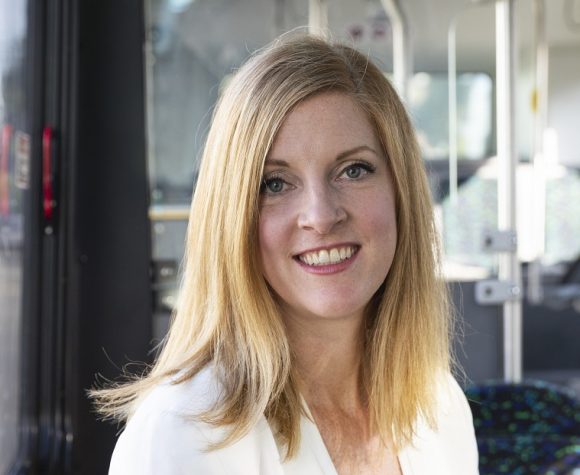By Natalie Bruckner. Originally published in the winter 2019 edition of Business Class magazine.
“Welcome onboard your personalized drone carrier. Please be sure you are safely buckled up before take off. We will be arriving at your destination in less than three minutes. Sit back and enjoy the ride and don’t forget to provide us with feedback via our online virtual assistant.”
While this may read like something out of a sci-fi book, the idea of passenger-carrying drones as a mode of public transit isn’t so far-fetched when you consider the advancements that the sector has recently made here in British Columbia.
“We often have discussions about transportation going into ‘the vertical,’ as we call it, especially with companies like Amazon now moving into that realm with deliveries by drone…anything is possible,” says Erinn Pinkerton, BCom ’01. Pinkerton is president and CEO of BC Transit, the provincial Crown corporation responsible for delivering public transportation across the province, with the exception of those areas serviced by TransLink (Metro Vancouver).
Over the past five years, public transportation in BC has undergone a massive change, but this is just the beginning.
Increasingly stringent emission regulations, advancements in technologies, market disrupters like ride-sharing as well as customer expectations are just some of the reasons BC Transit and TransLink are exploring ideas that may have been laughed out of the boardroom just a few years ago.
“The industry is changing as customer expectations are changing. On a macro level, we have to make sure we stay abreast of technology, and at the micro level that means we are considering what we can do to mirror some of the benefits that technology brings by offering more dynamic transit,” says Pinkerton.
Increasing passenger numbers is helping drive this innovative mindset as more people leave their cars at home and rely on public transportation as their main means of getting around.
“Over the past three years, ridership on TransLink’s system has grown by 18 per cent—the largest increase in all of North America and far outpacing the growth in local population and employment,” explains Steve Vanagas, MBA ’01 and vice president, communications, marketing and public affairs at TransLink. “We are in the midst of a $9-billion plan to improve transit and transportation in the Metro Vancouver region.”
BC Transit has also seen an increase in ridership, growing by six per cent in 2018-2019 to just over 57 million passenger trips annually. The trend is expected to continue in both regions.
“There is a new appreciation for the vital role that public transportation plays in the economic and social success of our communities,” says Vanagas.
You can’t talk about social and economic success without looking at what public transportation is doing when it comes to reducing its carbon footprint. Currently transportation is said to produce 24 per cent of Canada’s total emissions. And while public transportation produces significantly less greenhouse gas emissions per passenger kilometer than private vehicles, the sector is looking to further reduce its impact.
“The industry is changing since we know we can’t build ourselves out of congestion anymore and there needs to be an alternative solution. Customers today are not choosing transit solely based on finances, but because they see it as a green solution. It takes people off the roads, and that’s why we are moving to a zero-emission fleet,” says Pinkerton.
In July, BC Transit announced the launch of the low-carbon fleet program that aligns with the Province of BC’s CleanBC plan, aids provincial targets for greenhouse gas (GHG) emissions and supports local government climate action goals. Its target is to create a fully electric provincial fleet in all vehicle classifications by 2040.
“The exciting part about a public agency, given our size and our ability to work with others like BC Hydro and the provincial and federal governments, is that we can accelerate a program more quickly than an individual car owner deciding to go electric,” says Pinkerton.
This summer TransLink introduced its battery-electric bus pilot—a $10-million project that will test how well buses powered by fast-charging batteries work. TransLink started rolling out the electric buses for a two-and-a-half year trial on Route 100, travelling along Marine Drive through Vancouver, Burnaby and New Westminster. High-powered charging stations, capable of recharging the bus batteries within four to seven minutes, are being installed at each end of the route.
“The big picture for us at BC Transit is that electric buses will not only be reducing emissions out of the tailpipe, but they will be quieter, which is essential for community roads and on-demand services,” says Pinkerton.
On-demand services, you say? Yes, don’t be surprised if in the next few years you can book a door-to-door public transportation service on your phone…from anywhere. Rather than being concerned about the increasing popularity of ride shares, public transportation is embracing it and the opportunities it presents.
“It’s exciting to see the choices that people are going to have. Fast, frequent bus and rapid transit, ride sharing and car-sharing, e-bikes and e-scooters—there will be more choices than ever before. We see TransLink as being central to ensuring that those choices help reduce congestion, create more opportunity and make our communities more sustainable,” says Vanagas.
However, as Pinkerton says, it’s not just about reducing emissions and creating more efficient service, but about the emotional connection.
“When you look at Uber and Lyft coming into the province, anyone who has taken one is not excited because it’s an Uber or Lyft, but because it’s interactive: you get to book your trip, know where your driver is and his or her name. You know where they are taking you, you have the convenience of paying for it on your phone, and you can rate your driver,” says Pinkerton.
Local transit has already started making headway in this realm. Since 2018, BC Transit real-time bus location technology (NextRide) has rolled out in seven transit systems, including Victoria, Nanaimo, Comox Valley, Squamish, Whistler, Kamloops and Kelowna. It allows customers to use BC Transit’s website or their mobile devices to track the location of their bus. It also helps remove barriers for the visually impaired by enabling automatic next stop annunciation, and provides passenger information displays on board buses and at selected bus stops to assist those with hearing impairments.
Vanagas says it’s all about getting customers more personalized information, faster.
Ride-on-demand services will also benefit those in rural communities as the sector explores how to better serve those routes. In the past, it has been difficult to provide public transit in a reasonably efficient way to some low-density, rural areas. However, as Pinkerton explains, this is about to change.
“I am 100 per cent confident that fixed route, high-capacity transit will always have its place, but we are entering into more unique services. Take UVic as an example. Currently we drop everyone off at the Exchange, but how do you get to your home at the end of the day? This is where we start to look at on-demand bus scheduling—moving away from a fixed route to a pick-up/drop-off—as we can use technology to facilitate that,” says Pinkerton.
Before we transition to that point, the next stop is riders using current technology to pay for fares on their phones. “The traditional approach with the fare card means the backend system has to be up-to-date; you have to administer the cards, and if they get lost, it is a bureaucratic and administrative challenge. When customers bring their phones on the bus, they bring their own tickets and remove everything we have to do on the back end. We are actively pursuing the product right now with the goal that within the year we have something started,” says Pinkerton.
Pinkerton and Vanagas understand that by working in transportation, well, no two days are ever the same. “Technology is changing, so we need to be sure we are nimble enough and choose our products wisely, and we are not stuck on legacy systems. It’s a hard thing to get to. If we wait until it’s perfect, we won’t ever get anywhere,” says Pinkerton.
So what’s the most challenging element moving forward? They both agree that it’s about constantly meeting customer expectations, 24/7.
“We are very real and very relevant to the lives of a half-million people who use our system every day to get around. It’s a big responsibility. We have a huge impact on virtually everyone in this city and that’s why we have to listen to people. We have to work hard every day to provide a safe and reliable service, and we have to think and plan for the future,” says Vanagas.
They also both agree that when you choose to work in transit, you’re only as good as the last trip you provided for that customer. That’s a big responsibility to carry.
“It’s not like flying, where you may take a trip once a year. In some cases it’s three or four times a day. You can have five good days and then one bad day on the system and it impacts you,” says Pinkerton. “I have become almost obsessed with how a massive agency works and how it breaks down into the minute-by-minute experience of our customers.”
Related reading: Q&A with Erinn Pinkerton | Q&A with Steve Vanagas




